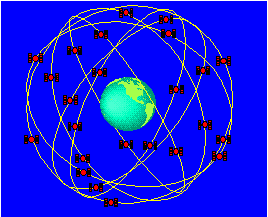
Using GPS to measure earthquakes
GPS is being used by scientists to study
the ongoing deformation of the crust in Southern California caused by
the San Andreas fault and other faults in the LA Basin. The Southern California
Integrated GPS Network (SCIGN) measures the millimeter-scale movements
of the crust between earthquakes, and also records displacement of stations
during earthquakes, but it does not measure the actual shaking of the
ground caused by an earthquake.
As you learned in previous sections, earthquakes
can be measured in a variety of ways. Traditionally, earthquake size has
been determined by various seismologic methods, which examine the amount
of shaking, which directly relates to the energy released in an earthquake.
GPS measures the size of an earthquake by
examining the final amount that a station has been displaced in an event.
This is done by examining the total distance that a station has moved
in an earthquake by comparing its position prior to the event with its
position following the event.
Scientists have found that there is a relationship
between the amount of displacement caused by an earthquake and its magnitude.
It is by using this relationship between slip and magnitude that scientists
can measure the relative size of an earthquake using GPS.
GPS is not used to measure the actual shaking
of the ground because of the way in which the actual data are collected.
Data are sampled at a certain rate, called a sample
rate, which means that the receiver records the information
being sent to it from the satellites at a certain interval of time all
day long.
For example, data can be sampled at a 30-second
interval, which means that the receiver records information from the satellite
every 30 seconds. That means that if the shaking from the earthquake lasts
any less than 30 seconds, it will be missed by the receiver.
Because of this, data are processed and
a daily solution
is determined, which means that the change in position of the receiver
is calculated for one day at a time by combining the data collected througout
the day. The data can also be processed at another solution
interval. For example, data could be sampled at a 1-second
rate and processed, but the solutions would be far less accurate than
the daily solutions.
This is the reason why GPS is not used to
directly measure the ground shaking during an earthquake. Seismometers
are much better equipped to accurately record that sort of high-freqency
motion than GPS. So, earthquake size
is determined instead by measuring the final displacement of the stations
and using the slip versus magnitude relationship.
What
is GPS?  How
does it work? How
does it work?  GPS
in earthquakes studies GPS
in earthquakes studies  Using
GPS to measure earthquakes Using
GPS to measure earthquakes
GPS
Activities
Last modified on 8/13/98 by Maggi Glasscoe (scignedu@jpl.nasa.gov)
|






